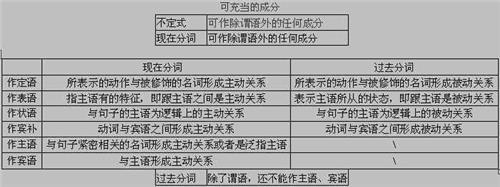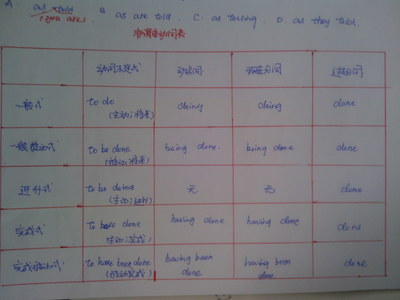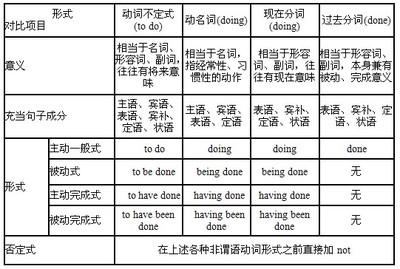一、关于动词适当形式的解题思路★★
时态(8种基本时态)
谓语动词——时间状语、语境——
语态(主动+被动)
动词
即将发生——不定式(todo)
非谓语动词——和中心词的逻辑关系 正在发生、主动——现在分词(doing)
已经完成、被动——过去分词(done)
充当名词——动名词(doing)
二、非谓语动词的分类功能表
类别
语 法 功 能
主语
宾语
宾语补足语
表语
定语
状语
不定式
√
√
√
√
√
√
动名词
√
√
√
√
现在分词

√
√
√
√
过去分词
√
√
√
√
三、做主语的非谓语动词比较
类别
注意点
例句
动名词
习惯性、经常性动作
Doing exercises regularly is good for your health.
不定式
一次性、具体性动作
To solve all the problems at once is impossible.
注:当动名词或不定式做主语时,更多的是用it做形式主语而把真正的主语转成不定
式置于句末。
It is good for your health to do exercisesregularly.
It is impossible to solve all the problems atonce.
某些特殊的形式主语结构,依然和动名词连用。
It is no use/good crying over the spilt milk.
四、做宾语的非谓语动词比较
类别
词例(仅限至本单元止已学过的动词,后学的请补充)
只与动名词连用
admit, dislike, imagine, delay, consider, mind, understand,avoid, enjoy, practise, miss, finish, keep, suggest, risk,overlook, advise, allow, forbid, appreciate, advocate, resist,stand, put off, can’t help, feel like, be worth
只与不定式连用
agree, beg, dare, decide, expect, fail, happen, hesitate, hope,intend, manage, prepare, pretend, promise, refuse, swear, wish,plan, get, help
两者皆用无区别
continue, prefer, begin, hate, start, love
两者皆用有区别
forget, remember, regret, mean, try, go on, like,need/want/require
注:①介词短语后面只接动名词,尤其关注介词to后接动名词的情况,易与不定式混淆。
如:pay attention to, look forward to, be/get used to, berelated/linked to, be the key to,
be on one’s way to, make contributions to, devote……to, thanksto, in addition to, object
to, prefer……to(仅限至本单元止已学过的动词,后学的请补充)
②尤其关注后接不定式和动名词时,区别很大的动词。
I forgot to returnthe money to you. 我忘记要还钱给你了。(钱未还)
I forgot returningthe money to you. 我忘记已经还过你钱了。(钱已还)
The headmaster havemeant to put off the sports meeting. 校长打算推迟运动会。
The heavy rain meansputting off the sports meeting. 大雨意味着运动会推迟了。
Tom tried to walkagain after his leg was badly hurt.(Tom努力地行走)
If you feel too full, youcan try walking after a meal. (你可以尝试着走走)
The computer needsrepairing. = The computer needs to be repaired.
③有些动词接动名词做宾语,但接不定式做宾补。
I consider buying a computer. Iconsider computers to be a useful tool of communication.
We don’t allow smoking here, so youare not allowed to smoke here.
Our theatre forbids taking dogs in. Weforbid people to take dogs in.
He advised asking our teacher forhelp. He advised us to ask our teacher for help.
五、做宾语补足语的非谓语动词比较(适用“解题思路”)
类别
与宾语的逻辑关系
例句
不定式
过程性、即将发生
I often hear her sing next door. (唱的过程)
We invited her to sing for her mum. (即将唱)
现在分词
主动性、正在进行
I heard her singing next door. (正在唱)
过去分词
被动性
I often hear the song sung by children. (被唱)
注:①某些动词接省to不定式做宾补,主要有一感(feel),二听(hear, listen to),三让
(make, let, have),六看(see, watch, look at, observe, notice,find),半帮助(help)。
但改为被动语态时,要将省略的to补出。
I often hear her sing next door. She is oftenheard to sing next door.
②很多形容词和名词做宾补的结构可以看作to be不定式的省略。
Hard work has made him (to be) a great man.
We consider Tom (to be) the cleverest in our class.
③一般不用being done, having been done做宾补。
如:I often hear the song being sung by them. (×)
六、做表语的非谓语动词比较
类别
注意点
例句
动名词
解释说明
名词用法
His habit is going to bed early and getting up early.
不定式
解释说明
My advice is to ask your teacher for help.
计划打算
动词用法
They are to start for New York tomorrow morning.
现在分词
现在进行时
Tom was doing his homework when I came in.
过去分词
被动语态
Much homework is given to us every day.
注:①区分动名词还是现在分词做表语的一个简单方法——“主表颠倒法”。
②动名词和不定式都可以做表语,解释说明主语的具体内容,但动名词更强调动作的
经常性和习惯性,不定式则侧重于一次具体的行为。
My job is looking after the twins. 我的工作是照顾这对双胞胎。(此人是保姆)
Today my job is to look after the twins.今天我的任务是照看这对双胞胎。(临时帮忙)
③不定式、现在分词、过去分词做表语的动词用法,适用“解题思路”。
④表达正在进行的被动时,用现在分词的被动形式“being done”做表语。
Many sea creatures are being wipedout by fishing boats.
七、做定语的非谓语动词比较(适用“解题思路”)
类别
逻辑关系
例句
不定式
即将发生
the scientist to visit our school
现在分词
主动性、正在进行
the visiting scientist at our school
过去分词
被动性、已经完成
the visited school by the scientist
动名词
用途、属性、特征
a swimming pool, a guessing game
注:①动名词和现在分词做定语的区别:前者强调用途属性,后者强调动作正在进行。
a swimming boy= a boy who is swimming
a swimming pool= a pool which is used for swimming
②非谓语动词做定语可以转化为定语从句,从句中谓语动词与关系词的逻辑关系
和非谓语动词与中心词的逻辑关系完全一致。
a scientist to visit our school = a scientist who willvisit our school (即将访问)
a visiting scientist at our school = a scientist whois visiting our school (正在访问)
the visited school by the scientist = the school whichis visited by the scientist (被访问)
③当中心词被only, last, next, 序数词和形容词最高级修饰时,只用不定式做定语。
Who is the first person to discover that the earthcircles the sun? (此处不用discovering)
④当不定式做定语时,主被动形式皆可;但如果出现了不定式的逻辑主语时,用
主动形式,不用被动形式。
There is much work to do/ to be done.
There is much work for me to do. I havemuch work to do. (此两句不用to be done)
⑤及物动词的过去分词体现被动关系,不及物动词的过去分词体现动作已完成。
the broken bike= the bike which isbroken
the beaten boy= the boy who was beaten
the retired worker= the worker who has retired
the fallen leaves= the leaves which havefallen
⑥选择分词做定语关键看逻辑关系——主动还是被动?正在发生还是完成?
a developing country (发展中国家) afalling leave (空中的落叶)
a developed country(发达国家) a fallen leave (地上的落叶)
boiling water(沸水) the escaping prisoner (正在越狱的囚犯)
boiled water(凉开水) the escaped prisoner (已经逃跑的囚犯)
⑦当逻辑关系是正在进行的被动时,用“being done”的形式做后置定语。
The waste being put back into the river has beenincreasing.
The airport being expanded will be stocked with the mostadvanced equipment.
I wonder who the computer being repaired belongs to.
⑧有些分词形式的形容词不体现动作,只体现感受。这种情况下,过去分词往往表达中心
语的感受,译成“感到……的”;现在分词往往表达中心语所引起的别人的感受,译成
“令人……的”。
We are pleased to hear about the pleasingnews.
He felt very tired after so many hours’ tiringwork.
An excited look came to his face when he saw theexciting result.
We are surprised to know the surprising boy whocould write many poems at the age of six.
八、做状语的非谓语动词比较(适用“解题思路”)
类别
与句子主语的逻辑关系
功能
例句
不定式
即将发生
目的状语
To catch up with others, he decided to work harder.
结果状语
He worked very hard, only to find he was still last.
现在分词
主动性、正在进行
伴随状语
He asked what had happened, pointing at the cut.
原因状语
Not having enough time, he had to start very early.
结果状语
The waste is put into the river, killing many fish.
条件状语
Preparing fully, we can achieve great things.
过去分词
被动性、已经完成
伴随状语
Encouraged by his words, I decided to work harder.
原因状语
Lost in my studies, I didn’t notice him come in atall.
条件状语
Given more time, we will surely do much better.
注:①在真正的实战练习中,我们无须过多地考虑功能,只要分析所要填的非谓语动词和
句子主语的逻辑关系即可。
②要特别关注不定式做结果状语的用法,此时不定式前往往有only, never,表示出人
意料或令人失望惋惜的结果。
She woke up, only to find herself locked in a darkhouse.
They left the hometown many years ago, never toreturn.
③现在分词做伴随状语时,为了强调非谓语动词发生在谓语动词前而不是同时发生,
我们采用having done的形式做伴随状语;但过去分词做伴随状语时,因为过去分
词本身可以体现动作的完成,所以可以不采用having been done的形式。
Having finished all the homework, Tom went out to playfootball happily.
上句不可用finishing,因为finish the homework和went out不可能同时发生。
(Having been) beaten by his father, the boy rushed out ofthe house.
④少数非谓语动词短语,作为固定的独立结构使用,不考虑与主语的逻辑关系。
To tell you the truth, you have made a big mistake.
To speak frankly, I see it slightly differently.
Generally speaking, every one of you has tried yourbest.
Judging from his appearance, he can’t be a thief.
Taken as a whole, there is nothing interesting in thebook.
He was lost in the forest. To make it worse,his food ran out.
 爱华网
爱华网



